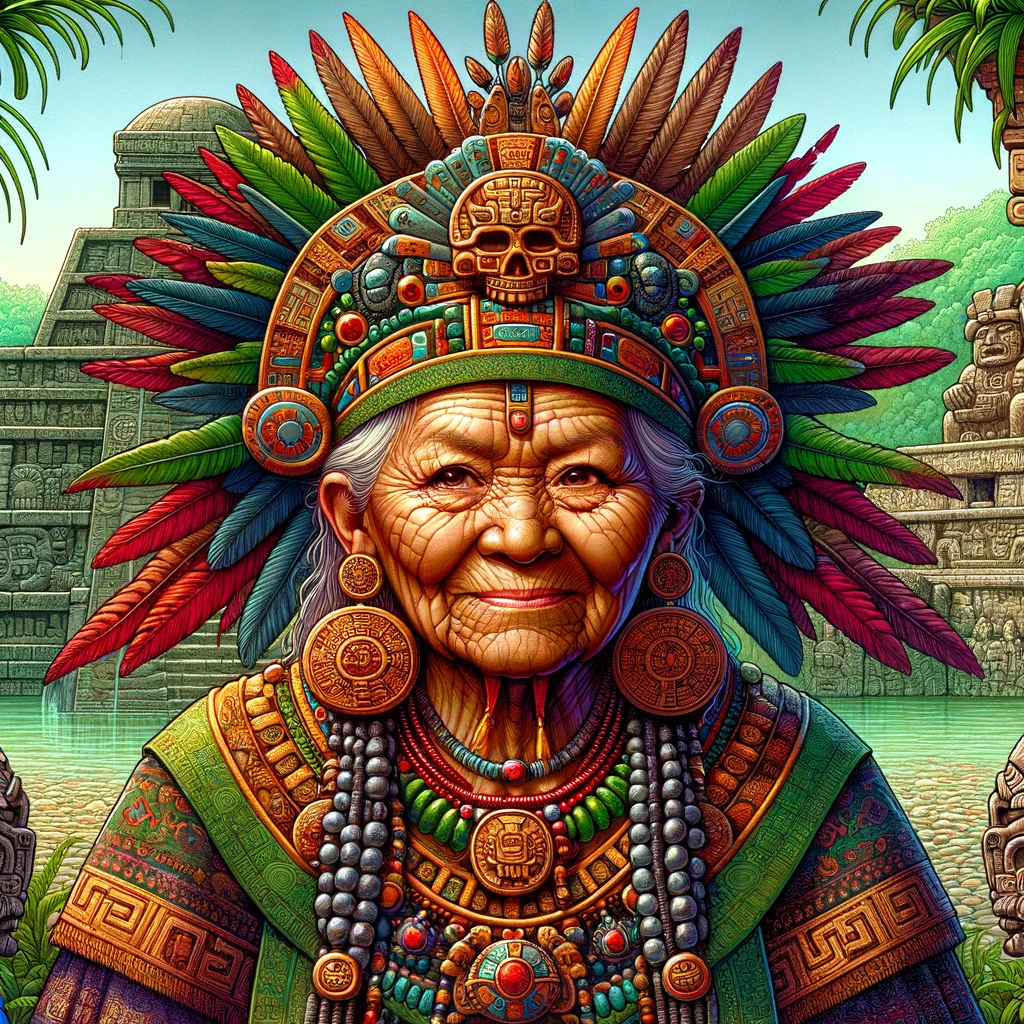
In the pantheon of Aztec mythology, few deities hold as significant a place as Toci, a goddess whose influence and reverence spanned across various aspects of Aztec life and culture. Often referred to as "our grandmother," Toci is a multifaceted deity embodying motherhood, earth, and healing, her persona weaving a tapestry of deep symbolism and cultural significance in the Aztec world.
Origins and Symbolism
The origins of Toci are as enigmatic as the deity herself. Regarded as a mother figure, she is often linked with the earth and the natural world, symbolizing the nurturing and life-sustaining aspects of nature. This connection with the earth also associates her with fertility and the cyclical nature of life, reinforcing her role as a mother figure not just to the Aztecs but to the universe itself.
Depictions and Associations
In Aztec art and iconography, Toci is depicted in various forms, often adorned with distinctive symbols of her divine status. She is usually shown wearing traditional skirts and adorned with intricate jewelry, emphasizing her connection to motherhood and the earth. Additionally, she is sometimes depicted with attributes of warfare, such as shields or war attire, suggesting a protector aspect.
One of the most striking features in depictions of Toci is the presence of two faces or heads, symbolizing duality - a common theme in Aztec mythology. This duality may represent the contrasting aspects of life and death, creation and destruction, or the earthly and the spiritual realms.
Toci in Rituals and Worship
Toci's significance is evident in the numerous festivals and rituals dedicated to her. These ceremonies often involved offerings and sacrifices, reflecting the Aztecs' deep reverence for their deities. In particular, Toci was a central figure in rituals related to fertility and healing, where her blessings were sought for bountiful harvests and the well-being of the community.
The practice of venerating Toci was not limited to grand public ceremonies; she also played a crucial role in personal and domestic rituals, especially those involving women and childbirth. As a mother figure, Toci was invoked for protection during childbirth and for the general well-being of children.
Toci's Legacy and Modern Interpretation
The legacy of Toci extends beyond the realm of ancient Aztec religion; she remains a subject of interest and study in modern times. Scholars and enthusiasts of Mesoamerican cultures continue to explore her role and significance, unraveling the layers of symbolism and mythology surrounding this enigmatic deity.
In contemporary times, Toci has also become a symbol of empowerment, especially for women, embodying strength, nurturing, and resilience. Her image and story continue to inspire and resonate, transcending the boundaries of time and culture.
Conclusion
Toci, the revered Aztec deity, holds a unique place in the tapestry of Aztec mythology. As a symbol of motherhood, earth, and healing, her influence permeated every aspect of Aztec life. The reverence for Toci highlights the Aztecs' deep connection with the natural world and their understanding of the complexities of life and the universe. Today, Toci's legacy continues, offering a window into the rich and intricate world of Aztec mythology and culture.
Origins and Symbolism
The origins of Toci are as enigmatic as the deity herself. Regarded as a mother figure, she is often linked with the earth and the natural world, symbolizing the nurturing and life-sustaining aspects of nature. This connection with the earth also associates her with fertility and the cyclical nature of life, reinforcing her role as a mother figure not just to the Aztecs but to the universe itself.
Depictions and Associations
In Aztec art and iconography, Toci is depicted in various forms, often adorned with distinctive symbols of her divine status. She is usually shown wearing traditional skirts and adorned with intricate jewelry, emphasizing her connection to motherhood and the earth. Additionally, she is sometimes depicted with attributes of warfare, such as shields or war attire, suggesting a protector aspect.
One of the most striking features in depictions of Toci is the presence of two faces or heads, symbolizing duality - a common theme in Aztec mythology. This duality may represent the contrasting aspects of life and death, creation and destruction, or the earthly and the spiritual realms.
Toci in Rituals and Worship
Toci's significance is evident in the numerous festivals and rituals dedicated to her. These ceremonies often involved offerings and sacrifices, reflecting the Aztecs' deep reverence for their deities. In particular, Toci was a central figure in rituals related to fertility and healing, where her blessings were sought for bountiful harvests and the well-being of the community.
The practice of venerating Toci was not limited to grand public ceremonies; she also played a crucial role in personal and domestic rituals, especially those involving women and childbirth. As a mother figure, Toci was invoked for protection during childbirth and for the general well-being of children.
Toci's Legacy and Modern Interpretation
The legacy of Toci extends beyond the realm of ancient Aztec religion; she remains a subject of interest and study in modern times. Scholars and enthusiasts of Mesoamerican cultures continue to explore her role and significance, unraveling the layers of symbolism and mythology surrounding this enigmatic deity.
In contemporary times, Toci has also become a symbol of empowerment, especially for women, embodying strength, nurturing, and resilience. Her image and story continue to inspire and resonate, transcending the boundaries of time and culture.
Conclusion
Toci, the revered Aztec deity, holds a unique place in the tapestry of Aztec mythology. As a symbol of motherhood, earth, and healing, her influence permeated every aspect of Aztec life. The reverence for Toci highlights the Aztecs' deep connection with the natural world and their understanding of the complexities of life and the universe. Today, Toci's legacy continues, offering a window into the rich and intricate world of Aztec mythology and culture.